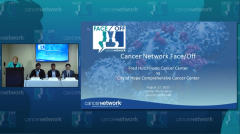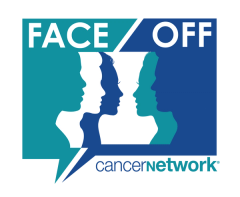
Cross Q&A: Managing Cardiovascular Risks in CML Treatment
A panel of experts discusses the challenges and considerations surrounding cardiovascular risks associated with ponatinib treatment for chronic myeloid leukemia, emphasizing the need for multidisciplinary collaboration and individualized treatment strategies.
Episodes in this series

Transcript:
Rahul Banerjee, MD, FACP: I’m just going to say [regarding] the cardiologist and the neurologist changing the AOEs, for myeloma, we all pretend that we’re ID [infectious disease] doctors for BCMA [B-cell maturation antigen] bispecific infections. I think we need some more ID docs on our panels to figure out what’s attributable and what’s not. It’s fascinating.
Vivian G. Oehler, MD: I know the longer you live with effective therapy, the more issues crop up, right? And then you start to need help. So, and just to complete this, as I’ve discovered, I can only treat CML [chronic myeloid leukemia] and MPNs [myeloproliferative neoplasms], and I know nothing. Apparently, I’m taking the boards, but I’ve also learned [to] go for help. So, we’re a little spoiled in the academic setting. But when I do have a risky drug like this—because it’s not perfect, these numbers still are real—then I manage with cardio-oncology or with cardiology, and, really, it’s hypertension. It’s hypertension within the first 4 to 8 weeks. Make sure you start an anti-hypertensive drug, and I think that really helps.
Judy Schreiber, PhD, RN: Well, thank you. That was a fantastic discussion back and forth. We do have a question from the audience.
Audience Member: Hi,…I’m one of the fellows at City of Hope. On that note, how well-controlled does the hypertension have to be? What range are we looking for? Or do we have that data?
Paul B. Koller, MD: So, I…alluded to this. I think this is an area where we could improve a lot. It’s just this…like vague catch-all term of risk factor reduction. So…if a statin is indicated, a statin, a low threshold for an aspirin, good aggressive blood pressure control. Unfortunately, we have to put our…internal medicine hat on with CML. I don’t know, but Vivian, do you [have any thoughts]?
Vivian G. Oehler, MD: I actually will make patients check their blood pressures at home. And mainly because my patients live so far away. They could be like 7 or 8 hours away. And I find that diastolic blood pressure goes up. So, to answer your question, I find that these blood pressures creep above 140/90 [mm Hg], and I select group of patients, completely dose-related, too. So, the lower the dose, the less [hypertension]. I know in primary care that we’re aiming for 120/80 [mm Hg] nowadays. I try to keep you less than 140/90 [mm Hg]. And then, [I’m] less a fan of aspirin more a fan of statins. And the number is…really hard to know, right? So I help my cardiologist too. What are the risk factors? Many come on statins. But part of me thinks that the mechanism of protection may actually be statins rather than aspirin. But again, because we don’t fully understand the mechanism, I can’t support that with any good data.
Judy Schreiber, PhD, RN: Fantastic. Thank you.
Murali Janakiram, MD, MS: Just on the same note. I also have to take my boards, so it’s better for me to learn. Antithrombotics have been shown to influence this. One antithrombotic, two antithrombotics, [these are] not necessarily in the studies.
Vivian G. Oehler, MD: So, unfortunately, ponatinib has a bleeding risk, too, and so, I would worry about an increased risk for bleeding, if we use those. But again, great question. I think we just don’t understand the mechanism. And Dr Koller, I didn’t mean to cut you off.
Paul B. Koller, MD: No, I was going to actually defer to you on that…. Just to piggyback on the mechanism, I think this is like a real earnest biological question in the field as to whether it’s an off-target effect of ponatinib or there are some [who] think it’s an on-target effect of a better BCRA, that there’s something to do with…really good BCR-ABL targeting.
Vivian G. Oehler, MD: I think that’s interesting, and because the asciminib is so potent, right? If it were to be potent inhibition, then we’d have to really follow those data—it’s an interesting point—versus some endothelial cell target. And there have been some data from OHSU. Some cardiologists had some mouse models looking into some of it. So there is some understanding, but I think, clinically, we haven’t figured out what to do with it.
Transcript is AI-generated and edited for clarity and readability.
Newsletter
Stay up to date on recent advances in the multidisciplinary approach to cancer.



























































































